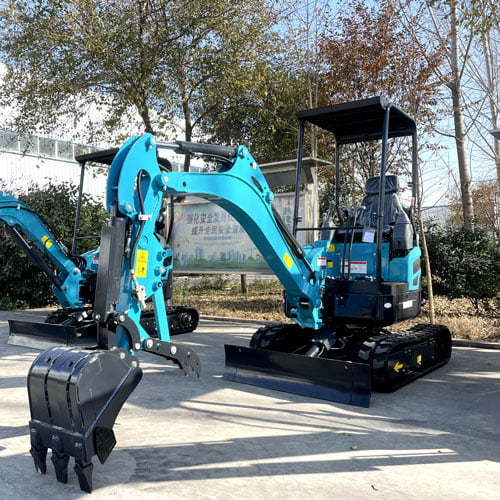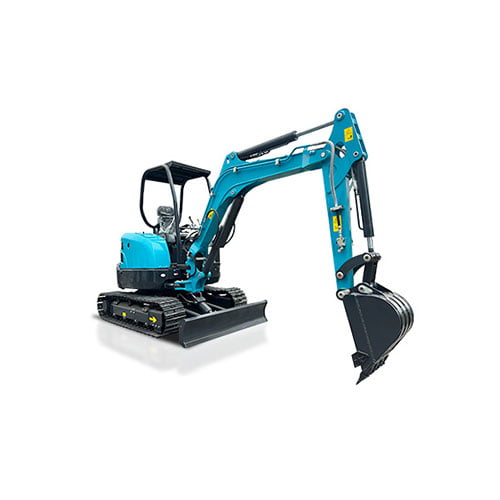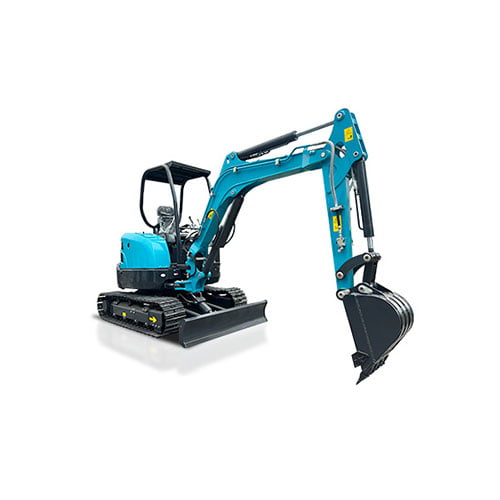Introducción
Mini excavators have become indispensable tools in the construction, landscaping, and agricultural industries. Their compact size, versatility, and efficiency make them ideal for a wide range of tasks, from digging and trenching to demolition and material handling. Choosing the best mini excavators for your project can significantly impact productivity and cost-effectiveness. This comprehensive guide will walk you through the key considerations, features, and benefits of selecting the best mini excavators to meet your specific needs.
Comprender las miniexcavadoras

What are Mini Excavators?
Mini excavators, also known as compact excavators, are small hydraulic machines designed for earthmoving tasks. They typically weigh between 1 to 10 tons and are equipped with a boom, dipper, and bucket.
- Definición: Small hydraulic machines for earthmoving tasks.
- Components: Include a boom, dipper, and bucket.
Key Features of Mini Excavators
Understanding the key features of mini excavators will help you choose the best one for your project. These features include:
- Peso operativo: Determines the stability and capacity of the excavator.
- Potencia del motor: Influences the machine’s performance and efficiency.
- Dig Depth: Maximum depth the excavator can dig.
- Bucket Capacity: Volume of material the bucket can hold.
- Swing Radius: The radius within which the machine can rotate.
Table: Key Features of Mini Excavators
| Característica | Descripción |
|---|---|
| Peso operativo | Stability and capacity of the excavator |
| Potencia del motor | Performance and efficiency |
| Dig Depth | Maximum depth the excavator can dig |
| Capacidad del cubo | Volumen de material que puede contener el cubo |
| Radio de giro | The radius within which the machine can rotate |
Benefits of Using Mini Excavators
Versatilidad y flexibilidad
Wide Range of Applications
Mini excavators are versatile machines that can be used for various applications, including digging, trenching, demolition, landscaping, and material handling. Their compact size allows them to operate in confined spaces where larger machines cannot.
- Excavación y zanjeo: Ideal for creating foundations and trenches.
- Demolición: Suitable for small-scale demolition projects.
- Paisajismo: Perfect for grading and planting tasks.
- Manipulación de materiales: Efficiently move materials on site.
Fijaciones y accesorios
The versatility of mini excavators is further enhanced by the availability of various attachments and accessories. These can be quickly swapped out to perform different tasks, making mini excavators incredibly adaptable.
- Cubos: Different sizes and types for various materials.
- Taladros: For drilling holes.
- Martillos hidráulicos: For breaking concrete and rocks.
- Agarra: For grabbing and moving debris.
Relación coste-eficacia
Lower Operating Costs
Mini excavators generally have lower operating costs compared to larger machines. They consume less fuel, require less maintenance, and have lower transportation costs due to their compact size.
- Eficiencia de combustible: Consumes less fuel than larger machines.
- Mantenimiento: Easier and cheaper to maintain.
- Transportation: Lower costs due to compact size.
Aumento de la productividad
The efficiency and versatility of mini excavators lead to increased productivity on job sites. They can complete tasks quickly and move easily between different work areas, reducing downtime and increasing overall efficiency.
- Eficiencia: Completes tasks quickly.
- Mobility: Easily moves between work areas.
Impacto medioambiental
Reduced Emissions
Modern mini excavators are designed with advanced engines that produce fewer emissions compared to older models and larger machines. This makes them a more environmentally friendly option for construction and landscaping projects.
- Advanced Engines: Produce fewer emissions.
- Eco-Friendly: Better for the environment.
Lower Noise Levels
Mini excavators tend to operate at lower noise levels than larger excavators, making them suitable for urban areas and noise-sensitive environments.
- Quiet Operation: Suitable for urban and noise-sensitive areas.
- Reducción del ruido: Minimizes disturbance to surroundings.
How to Choose the Best Mini Excavators
Assessing Your Project Needs
Project Scope and Scale
The scope and scale of your project are crucial factors in determining the best mini excavator for your needs. Consider the size of the area, the type of tasks, and the duration of the project.
- Area Size: Match the excavator size to the project area.
- Task Type: Identify specific tasks the excavator will perform.
- Duration: Consider the length of time the excavator will be used.
Tipos de tareas
Identify the specific tasks you need the mini excavator to perform. This will help you choose a machine with the appropriate features and attachments.
- Digging: Requires a machine with a good dig depth and bucket capacity.
- Zanja: Needs precise control and maneuverability.
- Demolición: Requires robust construction and hydraulic power.
Evaluating Key Features
Operating Weight and Size
Choose a mini excavator with an operating weight and size that matches your project requirements. Larger projects may require a more robust machine, while smaller projects can benefit from a more compact model.
- Peso operativo: Ensure stability and capacity for the project.
- Tamaño: Match the machine size to the project scale.
Potencia y rendimiento del motor
The engine power of the mini excavator affects its performance and efficiency. Ensure the machine has adequate power to handle the tasks you need to perform.
- Potencia del motor: Choose a machine with sufficient horsepower.
- Performance: Ensure the machine can handle the project demands.
Selecting Attachments and Accessories
Matching Attachments to Tasks
Select attachments that match the specific tasks you need to perform. This will enhance the versatility and efficiency of the mini excavator.
- Cubos: Choose the right size and type for the material.
- Taladros: For drilling and planting tasks.
- Hammers: For demolition and breaking tasks.
Quality and Compatibility
Ensure that the attachments are of high quality and compatible with the mini excavator model. This will ensure optimal performance and longevity.
- High Quality: Durable and efficient attachments.
- Compatibilidad: Match attachments to the machine model.
Budget and Financing
Consideraciones económicas
Set a budget for your mini excavator purchase and consider both the initial cost and long-term operating expenses. Higher-priced models may offer better features and durability, providing greater value in the long run.
- Presupuesto: Set a realistic budget for purchase.
- Value: Consider long-term benefits and operating costs.
Opciones de financiación
Explore financing options if the upfront cost is a concern. Many dealers offer financing plans that can make it easier to afford the best mini excavators for your needs.
- Financing: Look for flexible payment plans.
- Asequibilidad: Spread the cost over time.
Popular Brands and Models
Leading Brands
Several leading brands are known for producing high-quality mini excavators. These brands include:
- Caterpillar: Known for durability and performance.
- Komatsu: Offers advanced technology and efficiency.
- John Deere: Renowned for reliability and versatility.
- Bobcat: Known for compact and powerful machines.
Top Models
Here are some top models from leading brands that are highly recommended for various projects:
- Caterpillar 301.5: Compact and efficient for small projects.
- Komatsu PC30MR-5: Offers advanced technology and excellent performance.
- John Deere 35G: Versatile and reliable for a wide range of tasks.
- Bobcat E35: Powerful and compact, suitable for various applications.
Mantenimiento y cuidado

Mantenimiento periódico
Regular maintenance is crucial to keep your mini excavator in optimal condition. Follow the manufacturer’s maintenance schedule and perform routine checks.
- Routine Checks: Inspect and service the machine regularly.
- Manufacturer Schedule: Follow the recommended maintenance plan.
Troubleshooting Common Issues
Be aware of common issues that may arise with mini excavators and know how to troubleshoot them. This can help prevent downtime and extend the machine’s lifespan.
- Hydraulic Problems: Check for leaks and ensure proper fluid levels.
- Engine Issues: Regularly inspect and maintain the engine.
- Wear and Tear: Replace worn parts promptly.
Table: Maintenance Checklist for Mini Excavators
| Tarea de mantenimiento | Frecuencia |
|---|---|
| Inspect Hydraulic System | Semanal |
| Check Engine Oil | Diario |
| Clean Air Filters | Mensualmente |
| Lubricar las piezas móviles | Semanal |
| Inspect Tracks and Tires | Mensualmente |
| Sustituir piezas desgastadas | As Needed |
Conclusión
Elegir el las mejores miniexcavadoras for your project involves understanding your specific needs, evaluating key features, selecting the right attachments, and considering your budget. By taking the time to assess these factors, you can ensure that you invest in a machine that will enhance productivity, efficiency, and profitability on your job site. Regular maintenance and care will further ensure that your mini excavator remains in optimal condition, providing reliable performance for years to come.
PREGUNTAS FRECUENTES
What are the best mini excavators for landscaping projects?
The best mini excavators for landscaping projects typically include models like the Bobcat E35 and the John Deere 35G. These machines offer excellent maneuverability, versatile attachments, and precise control, making them ideal for detailed landscaping work.
How do I determine which are the best mini excavators for my needs?
To determine the best mini excavators for your needs, consider factors such as the size of your project, the types of tasks you will perform, and your budget. Evaluate the key features of different models, including operating weight, engine power, dig depth, and attachment compatibility.
What features should I look for in the best mini excavators?
The best mini excavators should have features like adjustable operating weight, powerful engines, sufficient dig depth, versatile attachments, and a comfortable operator cabin. Additionally, look for advanced technology features such as GPS and telematics for improved efficiency.
Are the best mini excavators also the most expensive?
Not necessarily. While some of the best mini excavators may come with a higher price tag due to their advanced features and durability, there are also cost-effective models that offer excellent performance and reliability. It’s important to balance your budget with the features and capabilities you need.
Can the best mini excavators be used for both digging and demolition?
Yes, the best mini excavators are designed for versatility and can handle both digging and demolition tasks. By equipping them with the appropriate attachments, such as hydraulic hammers for demolition and buckets for digging, they can efficiently perform a wide range of jobs.
What maintenance is required to keep the best mini excavators in top condition?
To keep the best mini excavators in top condition, regular maintenance is essential. This includes daily checks of engine oil and hydraulic fluid levels, weekly inspections of the hydraulic system and moving parts, monthly cleaning of air filters, and timely replacement of worn parts. Following the manufacturer’s maintenance schedule will ensure optimal performance and longevity.
How do the best mini excavators improve job site productivity?
The best mini excavators improve job site productivity by offering superior performance, efficiency, and versatility. Their compact size allows them to work in confined spaces, while advanced features and attachments enable them to complete tasks quickly and accurately, reducing downtime and increasing overall efficiency.
Where can I find reviews for the best mini excavators?
You can find reviews for the best mini excavators on industry websites, equipment dealer sites, and construction forums. Additionally, user reviews on platforms like YouTube and professional review articles can provide insights into the performance and reliability of different models.




